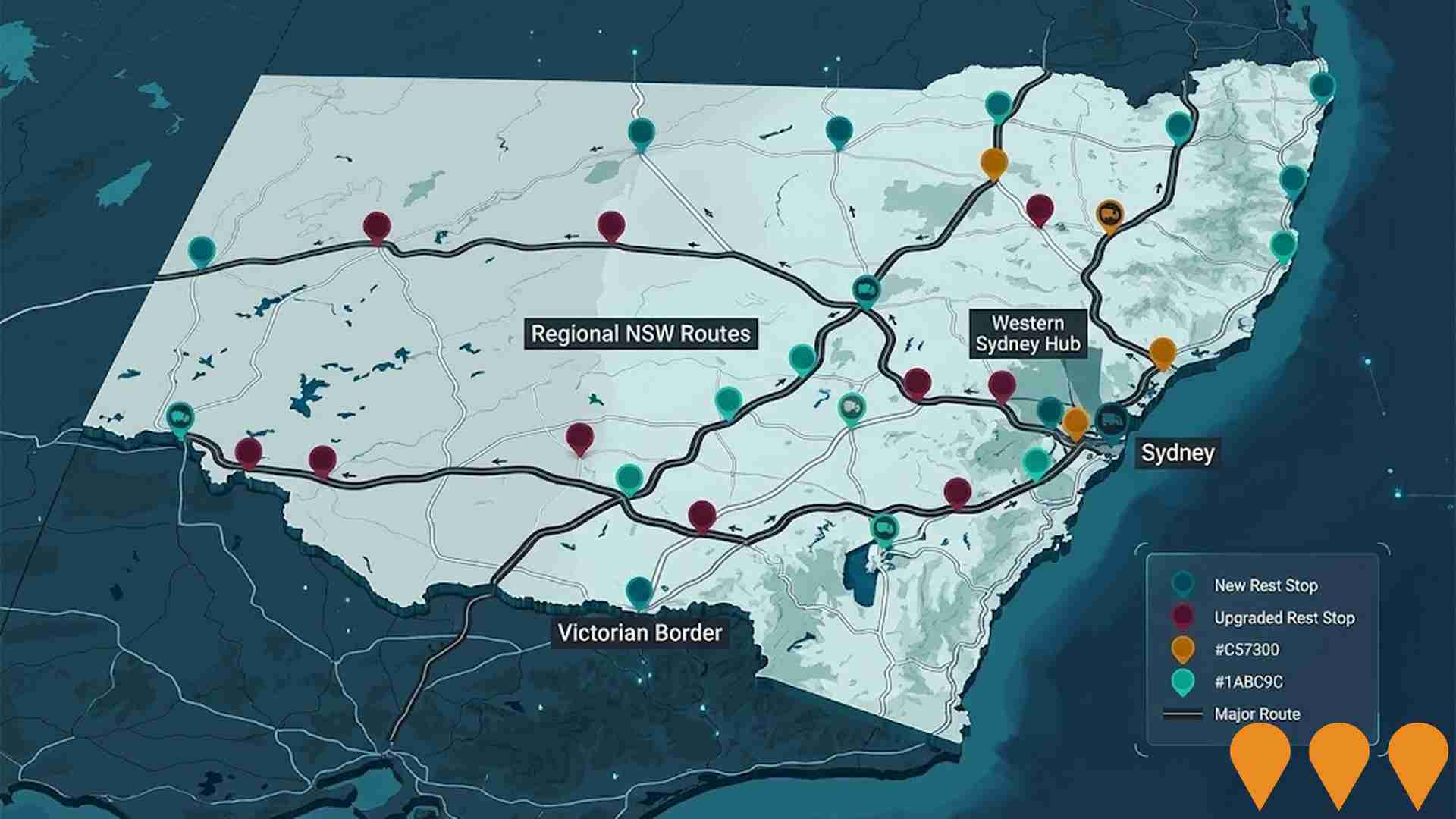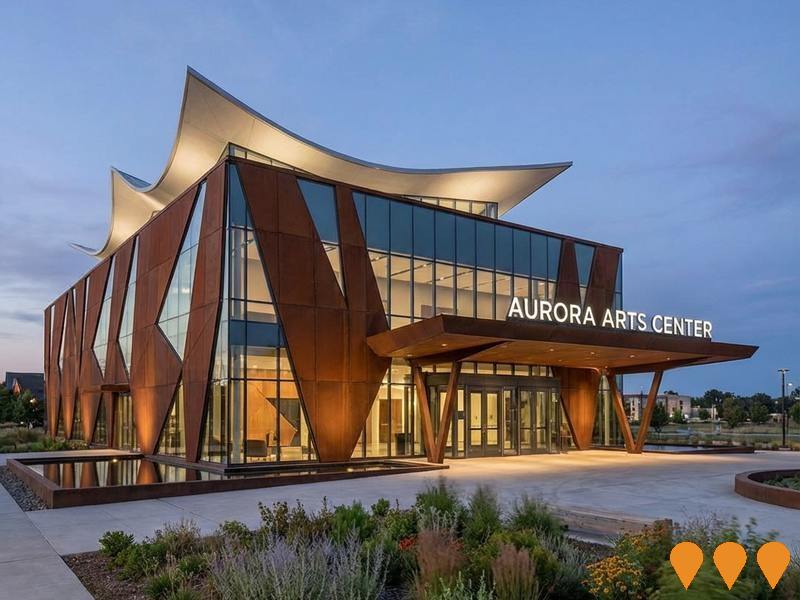Chart Color Schemes
est. as @ -- *
ABS ERP | -- people | --
2021 Census | -- people
Sales Activity
Curious about local property values? Filter the chart to assess the volume and appreciation (including resales) trends and regional comparisons, or scroll to the map below view this information at an individual property level.
Find a Recent Sale
Sales Detail
Population
An assessment of population growth drivers in Higgins reveals an overall ranking slightly below national averages considering recent, and medium term trends
Higgins's population was approximately 3,278 as of August 2025, a decrease of 43 people since the 2021 Census. The ABS estimated resident population in June 2024 was 3,278, with an additional 3 validated new addresses since the Census date. This resulted in a population density ratio of 1,962 persons per square kilometer. Natural growth contributed approximately 54.0% of overall population gains recently. AreaSearch adopted ABS/Geoscience Australia projections for each SA2 area, released in 2024 with a base year of 2022.
For areas not covered and years post-2032, ACT Government's SA2 area projections with a 2022 base were used. By 2041, the population is projected to decline by 386 persons, but the 85 and over age group is expected to expand by 64 people.
Frequently Asked Questions - Population
Development
AreaSearch assessment of residential development drivers sees a low level of activity in Higgins, placing the area among the bottom 25% of areas assessed nationally
Higgins has averaged approximately 14 new dwelling approvals annually over the past five financial years, totalling 74 homes. As of FY26, 78 approvals have been recorded. Historically, an average of 1.3 people per year moved to the area for each dwelling built between FY21 and FY25, indicating balanced supply and demand conditions. However, this has eased to 0.2 people per dwelling over the past two financial years due to improved supply availability. New properties are constructed at an average expected construction cost of $339,000.
In FY26, there have been $1.6 million in commercial approvals, suggesting minimal commercial development activity. Compared to the Australian Capital Territory, Higgins has around three-quarters the rate of new dwelling approvals per person and ranks among the 19th percentile nationally, offering limited choices for buyers and supporting demand for existing homes. New development consists of 21.0% detached dwellings and 79.0% medium and high-density housing, providing accessible entry options appealing to downsizers, investors, and entry-level buyers. This shift reflects reduced availability of development sites and addresses changing lifestyle demands and affordability requirements compared to the current housing mix of 96.0% houses. With approximately 818 people per approval, Higgins demonstrates a mature, established area with an expected stable or declining population, potentially reducing pressure on housing and creating opportunities for buyers.
With population expected to remain stable or decline, Higgins should see reduced pressure on housing, potentially creating opportunities for buyers.
Frequently Asked Questions - Development
Infrastructure
Higgins has emerging levels of nearby infrastructure activity, ranking in the 23rdth percentile nationally
Area infrastructure significantly impacts local performance. AreaSearch identified one major project affecting the area: Kippax Fair Expansion & Upgrade, The Valley Ponds - Stage 3 & Future Stages, Ginninderry Estate - Stages 4-7 (Strathnairn & future Macnamara), and New Northside Hospital are key projects.
Professional plan users can use the search below to filter and access additional projects.
INFRASTRUCTURE SEARCH
 Denotes AI-based impression for illustrative purposes only, not to be taken as definitive under any circumstances. Please follow links and conduct other investigations from the project's source for actual imagery. Developers and project owners wishing us to use original imagery please Contact Us and we will do so.
Denotes AI-based impression for illustrative purposes only, not to be taken as definitive under any circumstances. Please follow links and conduct other investigations from the project's source for actual imagery. Developers and project owners wishing us to use original imagery please Contact Us and we will do so.
Frequently Asked Questions - Infrastructure
Low and Mid-Rise Housing Policy
State-wide NSW planning reforms via amendments to the State Environmental Planning Policy to enable more diverse low and mid-rise housing (dual occupancies, terraces, townhouses, manor houses and residential flat buildings up to 6 storeys) in well-located areas within 800 m of selected train, metro and light-rail stations and town centres. Stage 1 (dual occupancies in R2 zones statewide) commenced 1 July 2024. Stage 2 (mid-rise apartments, terraces and dual occupancies near stations) commenced 28 February 2025. Expected to facilitate up to 112,000 additional homes over the next five years.
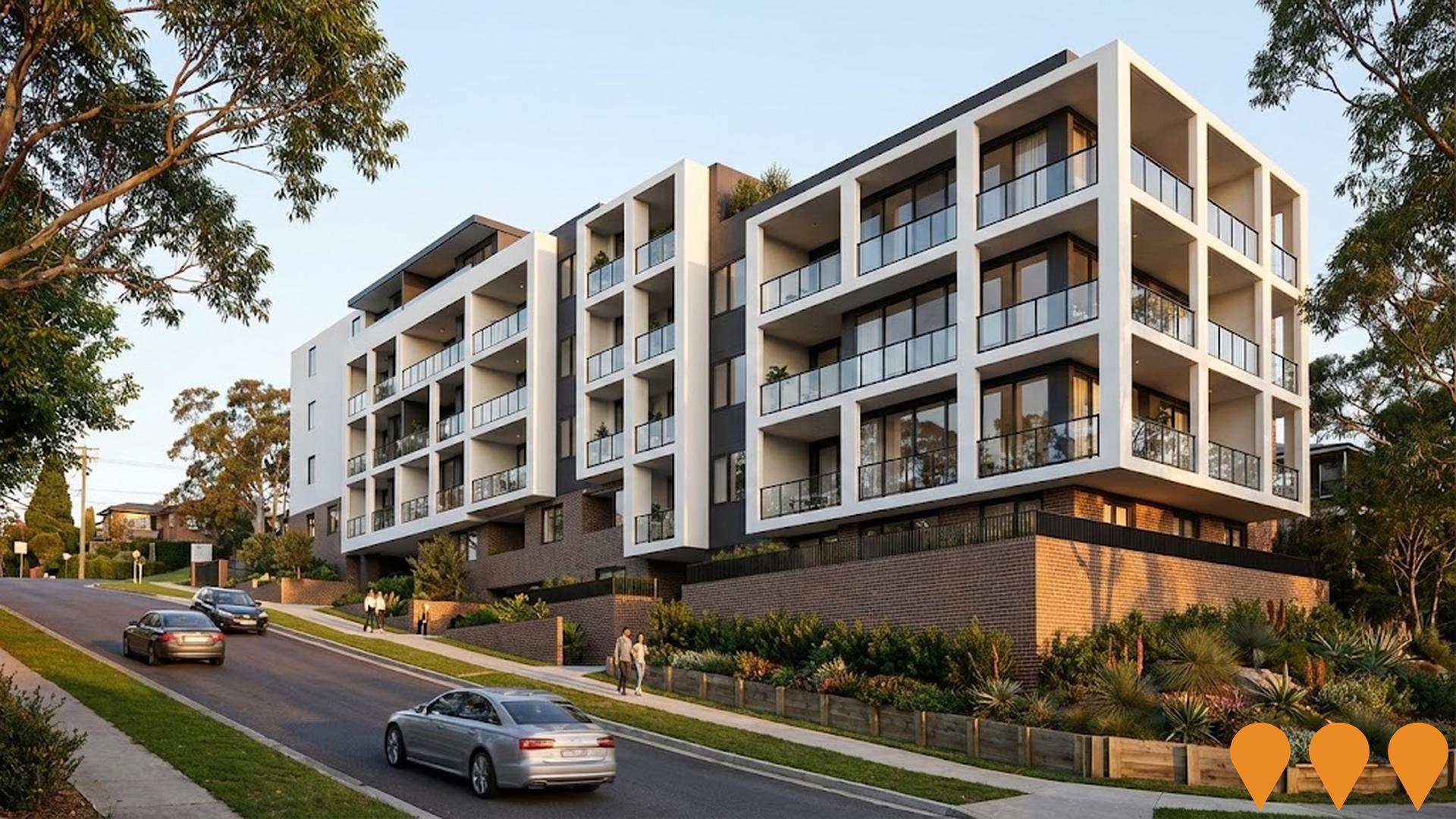
Ginninderry Estate - Stages 4-7 (Strathnairn & future Macnamara)
Canberra's largest master-planned community spanning the ACT-NSW border, delivering approximately 11,500 dwellings total, with ongoing stages immediately adjacent to and west of Dunlop.
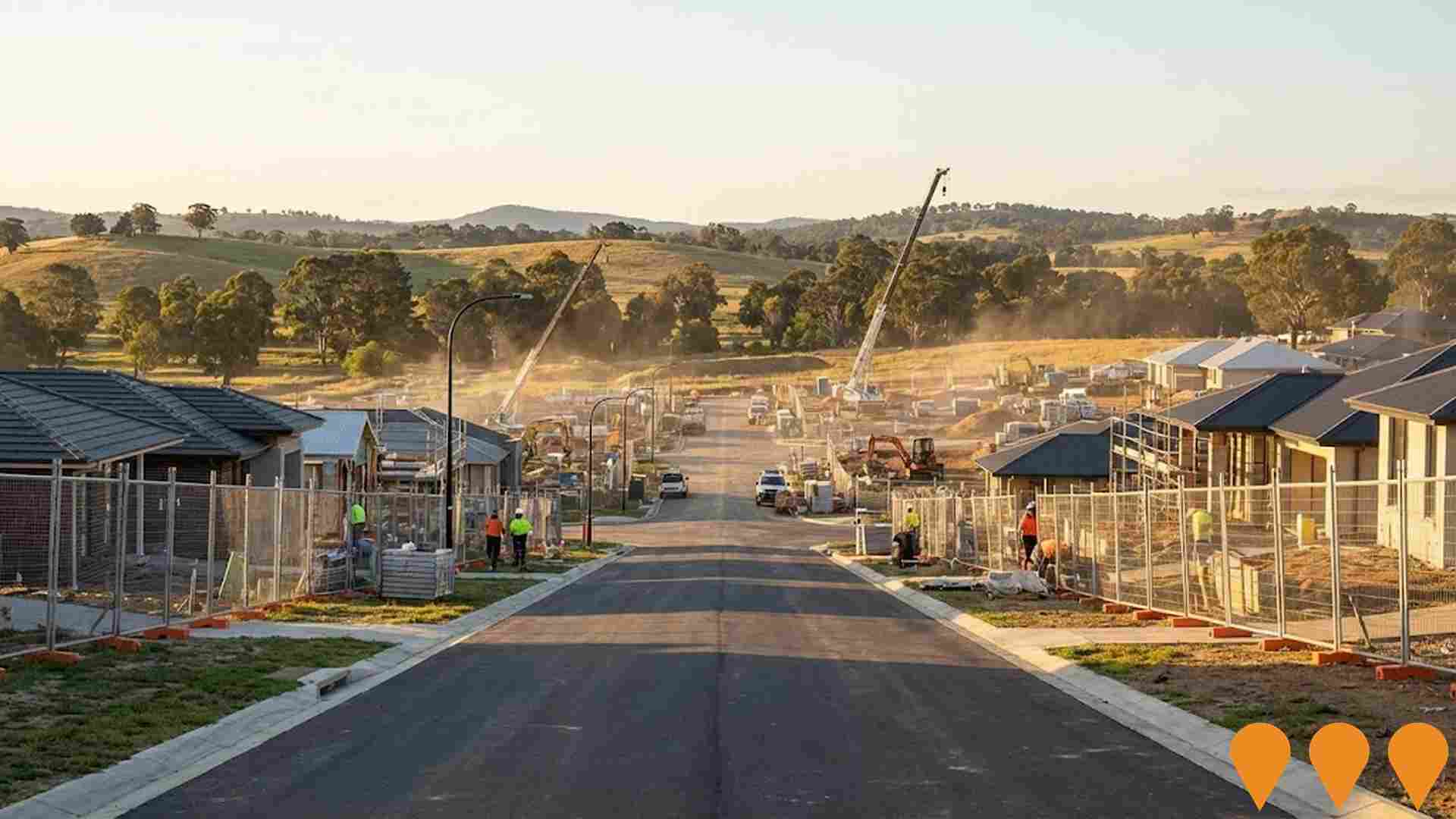
Enhanced bus and light rail corridors (Belconnen & Queanbeyan to Central Canberra)
ACT is progressing an integrated program to enhance high-frequency bus and future light rail corridors that link Belconnen and Queanbeyan with central Canberra. Light Rail Stage 2A (City to Commonwealth Park) commenced construction in early 2025 with services targeted from 2028, while planning and approvals continue for Stage 2B to Woden. The ACT Government has acknowledged and is planning upgrades for the Belconnen-to-City bus corridor as groundwork for a future east-west light rail Stage 3, and is coordinating cross-border public transport initiatives with NSW through the Queanbeyan Region Integrated Transport Plan and the ACT-NSW MoU for Regional Collaboration.
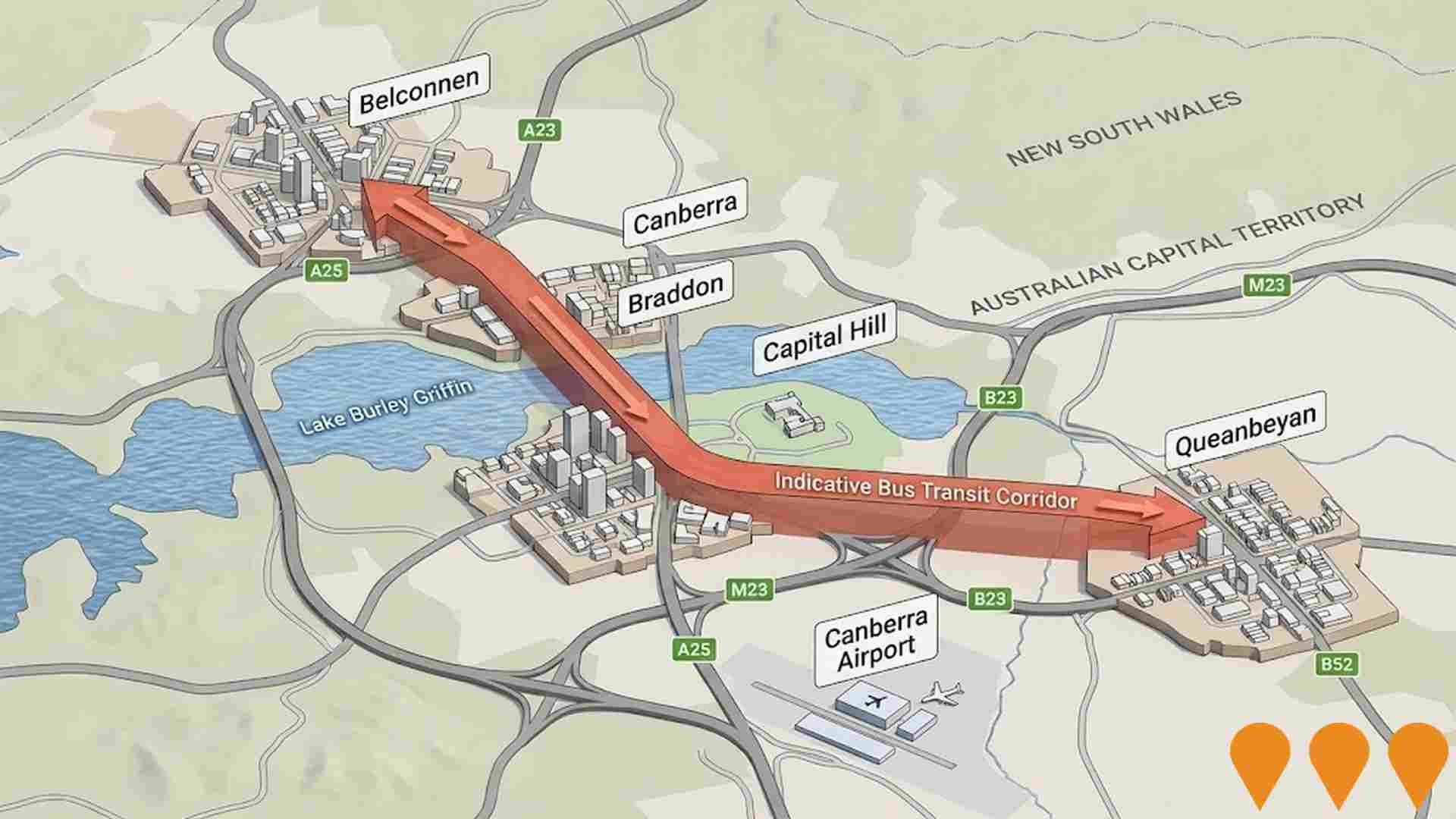
HumeLink
HumeLink is a new 500kV transmission line project connecting Wagga Wagga, Bannaby, and Maragle, spanning approximately 365 km. It includes new or upgraded infrastructure at four locations and aims to enhance the reliability and sustainability of the national electricity grid by increasing the integration of renewable energy sources such as wind and solar.
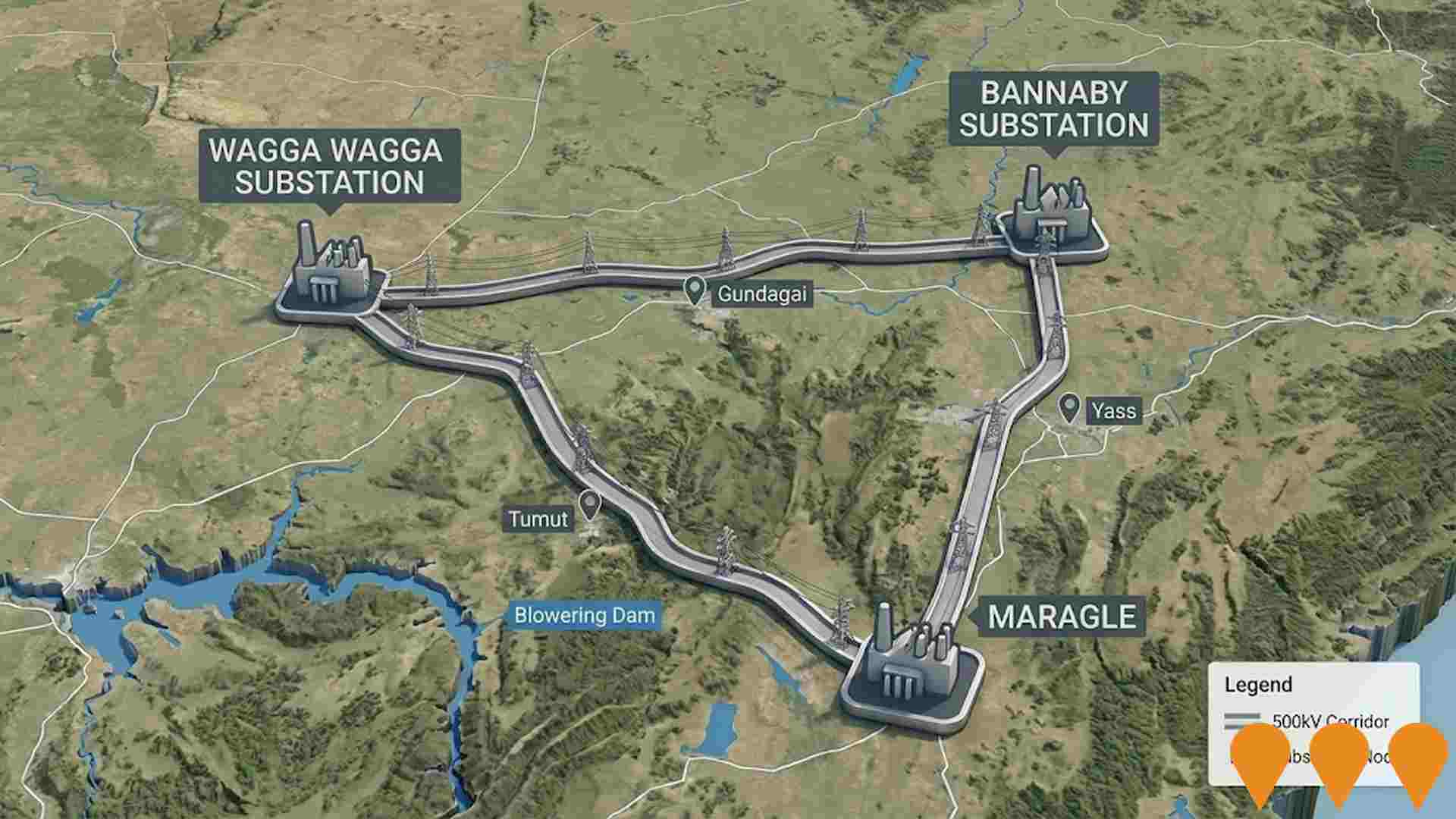
Kippax Fair Expansion & Upgrade
Significant expansion of Kippax Fair town centre serving Macgregor, Holt, and surrounding Belconnen west suburbs, adding new retail tenancies, medical centre, gym, and improved public realm.

Queanbeyan Regional Integrated Transport Plan
Comprehensive transport planning initiative with 64 key actions for next 10 years. Addresses road safety, active transport connectivity, public transport availability, and future transport needs. Improved connections between Queanbeyan and ACT.
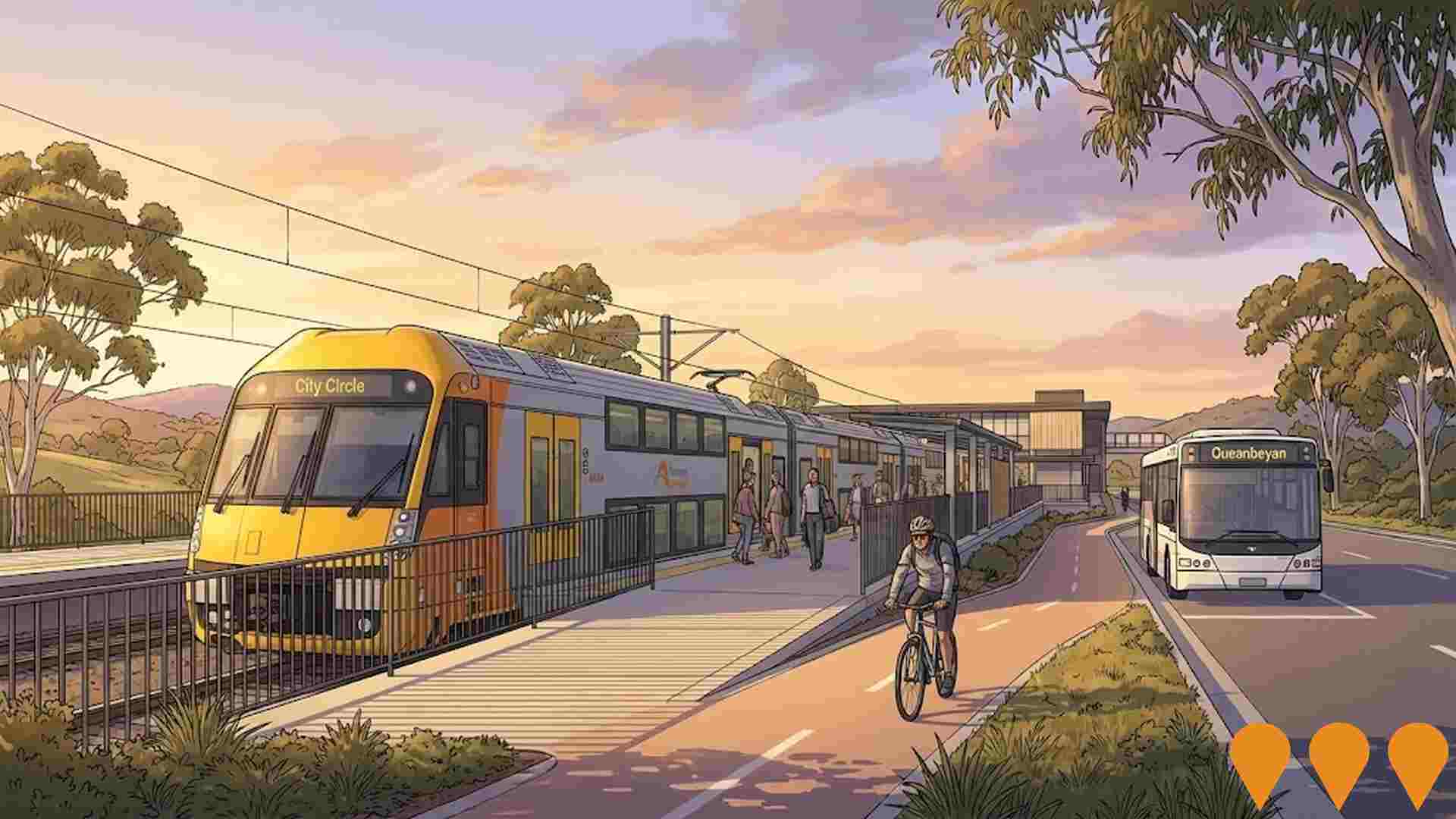
Big Canberra Battery (Williamsdale BESS)
A 250 MW / 500 MWh battery energy storage system at Williamsdale in southern Canberra, delivered by Eku Energy as Stream 1 of the ACT Government's Big Canberra Battery. Construction commenced in November 2024 with partners CPP and Tesla supplying Megapack systems. The asset will connect to Evoenergy's 132 kV network near the Williamsdale substation to provide two hours of dispatchable power, grid services and reliability for the ACT. Target operations in 2026.
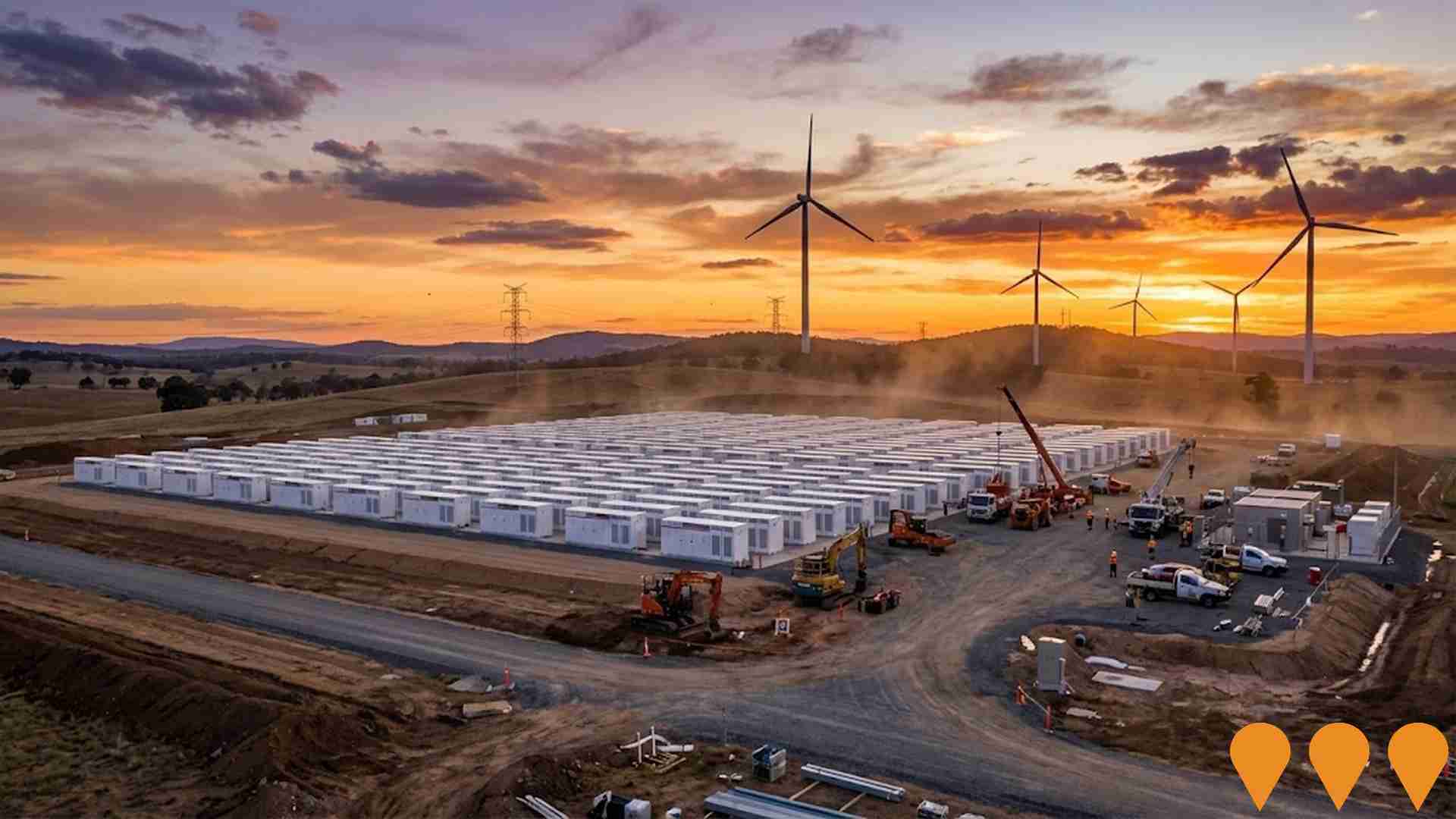
The Valley Ponds - Stage 3 & Future Stages
Final residential stages of the established Macgregor suburb, delivering over 400 new homes in The Valley Ponds precinct with direct frontage to the future Ginninderry conservation corridor and pond network.
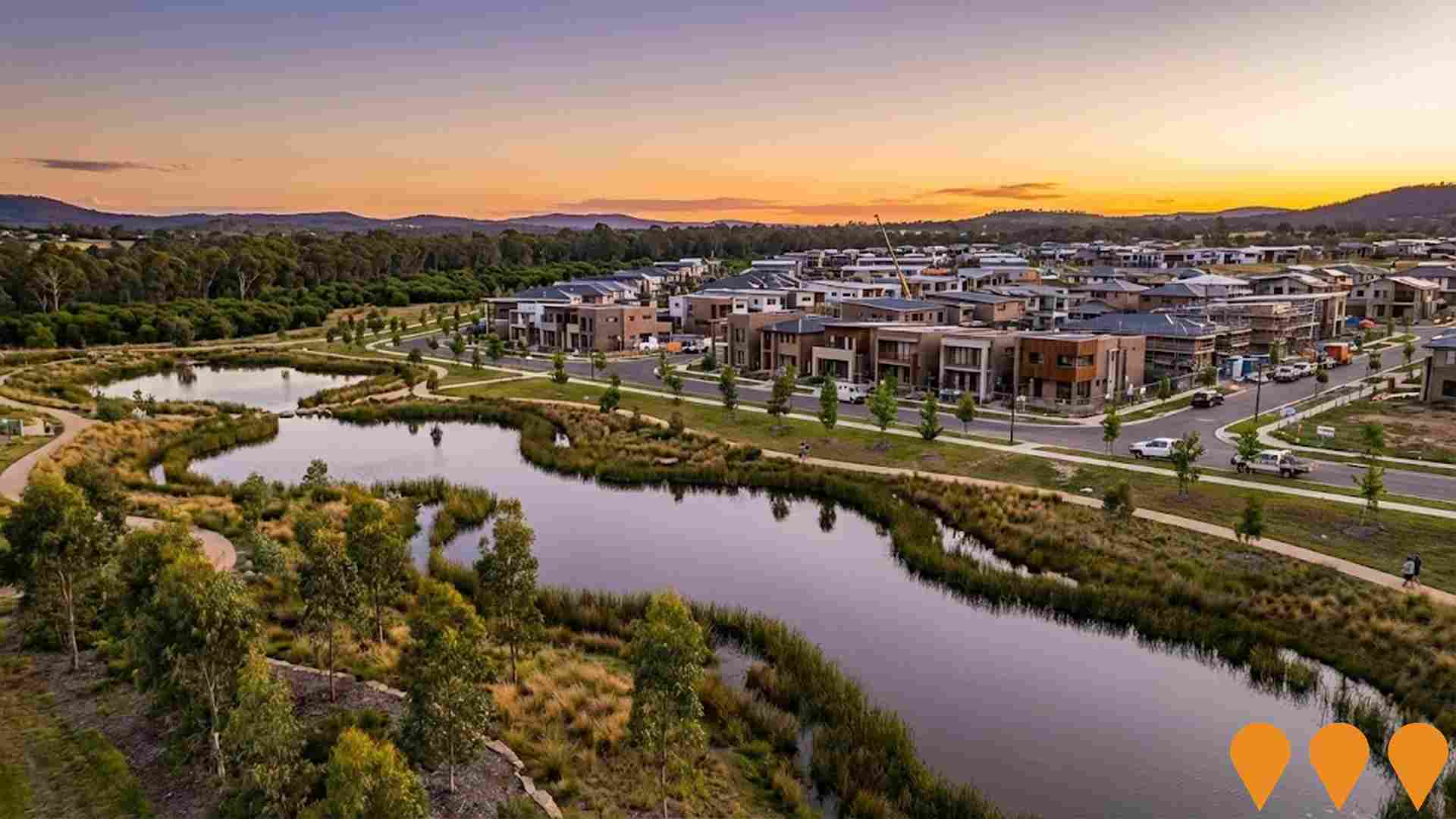
Employment
Employment performance in Higgins has been below expectations when compared to most other areas nationally
Higgins has an educated workforce with notable representation in essential services sectors. The unemployment rate was 5.5% as of the past year, with estimated employment growth at 2.8%.
As of June 2025, 1,700 residents are employed while the unemployment rate is 2.0% higher than the Australian Capital Territory's rate of 3.4%. Workforce participation in Higgins is lower at 65.4%, compared to the Australian Capital Territory's 69.6%. The dominant employment sectors among residents include public administration & safety, construction, and health care & social assistance. Construction shows strong specialization with an employment share of 1.6 times the regional level.
Public administration & safety is under-represented at 27.4% compared to the Australian Capital Territory's 30.4%. Limited local employment opportunities are indicated by the Census working population vs resident population count. Over a 12-month period, employment increased by 2.8%, labour force grew by 1.6%, and unemployment fell by 1.2 percentage points in Higgins. In comparison, Australian Capital Territory saw employment rise by 1.9%, labour force grow by 1.6%, and unemployment fall by 0.3 percentage points. Jobs and Skills Australia's national employment forecasts from May 2025 project national employment growth of 6.6% over five years and 13.7% over ten years, with varying rates between industry sectors. Applying these projections to Higgins's employment mix suggests local growth of approximately 6.4% over five years and 13.0% over ten years.
Frequently Asked Questions - Employment
Income
Income metrics indicate excellent economic conditions, with the area achieving higher performance than 75% of national locations assessed by AreaSearch
AreaSearch's data for financial year 2022 shows Higgins' median assessed income at $61,796 and average income at $69,852. This is higher than the national averages of $68,678 (median) and $83,634 (average) in the Australian Capital Territory. By September 2025, estimated median income would be approximately $70,200 and average income around $79,352, based on a 13.6% Wage Price Index growth since financial year 2022. Census data ranks Higgins' household, family, and personal incomes between the 81st and 83rd percentiles nationally. Income distribution shows 33.0% (1,081 individuals) earn between $1,500 - 2,999 weekly, similar to the surrounding region at 34.3%. Notably, 32.9% earn above $3,000 weekly. Housing accounts for 13.4% of income, and residents' disposable income ranks them in the 83rd percentile nationally. Higgins' SEIFA income ranking places it in the 7th decile.
Frequently Asked Questions - Income
Housing
Higgins is characterized by a predominantly suburban housing profile, with above-average rates of outright home ownership
As of the latest Census evaluation in Higgins, 95.7% of dwellings were houses, with the remaining 4.3% consisting of semi-detached homes, apartments, and other types of dwellings. In comparison, the Australian Capital Territory had 69.4% houses and 30.5% other dwellings. Home ownership in Higgins stood at 31.5%, with mortgaged dwellings at 45.5% and rented ones at 23.0%. The median monthly mortgage repayment in Higgins was $2,000, aligning with the Australian Capital Territory average, while the median weekly rent was $400 compared to the ACT's $2,000 and $430 respectively. Nationally, Higgins' mortgage repayments were higher than the Australian average of $1,863, and rents exceeded the national figure of $375.
Frequently Asked Questions - Housing
Household Composition
Higgins has a typical household mix, with a higher-than-average median household size
Family households constitute 75.0% of all households, including 34.0% couples with children, 28.5% couples without children, and 11.4% single parent families. Non-family households comprise the remaining 25.0%, with lone person households at 21.5% and group households making up 3.5%. The median household size is 2.6 people, which is larger than the Australian Capital Territory average of 2.5.
Frequently Asked Questions - Households
Local Schools & Education
The educational profile of Higgins exceeds national averages, with above-average qualification levels and academic performance metrics
The area's university qualification rate is 34.2%, significantly lower than the SA4 region average of 46.8%. Bachelor degrees are most common at 20.5%, followed by postgraduate qualifications (9.1%) and graduate diplomas (4.6%). Vocational credentials are held by 31.8% of residents aged 15+, including advanced diplomas (10.6%) and certificates (21.2%). Educational participation is high, with 29.4% of residents currently enrolled in formal education.
This includes 9.5% in primary, 8.5% in secondary, and 4.9% in tertiary education. Schools appear to be located outside the immediate catchment boundaries, requiring families to access them in neighboring areas.
Frequently Asked Questions - Education
Schools Detail
Nearby Services & Amenities
Transport
Transport servicing is high compared to other areas nationally based on assessment of service frequency, route connectivity and accessibility
Transport analysis indicates 31 active transport stops in Higgins, consisting of bus services. These are covered by seven distinct routes, offering 1,513 weekly passenger trips combined. Transport accessibility is rated highly, with residents usually situated 138 meters from the nearest stop.
Services average 216 trips daily across all routes, equating to roughly 48 weekly trips per individual stop.
Frequently Asked Questions - Transport
Transport Stops Detail
Health
Health performance in Higgins is lower than average with common health conditions somewhat prevalent across the board, though to a considerably higher degree among older age cohorts
Higgins faces significant health challenges with common health conditions being somewhat prevalent across the board, but to a considerably higher degree among older age cohorts. The rate of private health cover is very high at approximately 54% of the total population (~1,783 people), compared to 57.1% across Australian Capital Territory.
The most common medical conditions in the area are asthma and mental health issues, impacting 9.5 and 9.4% of residents respectively, while 65.2% declare themselves as completely clear of medical ailments, compared to 68.1% across Australian Capital Territory. As of June 30, 2021, the area has 18.2% of residents aged 65 and over (595 people), which is higher than the 15.3% in Australian Capital Territory. Health outcomes among seniors present some challenges that require more attention than those for the broader population.
Frequently Asked Questions - Health
Cultural Diversity
The level of cultural diversity witnessed in Higgins was found to be above average when compared nationally for a number of language and cultural background related metrics
Higgins' cultural diversity was found to be above average, with 23.8% of its population born overseas and 17.6% speaking a language other than English at home. Christianity was the main religion in Higgins, comprising 45.3% of the population. Hinduism was overrepresented compared to Australian Capital Territory figures, making up 2.4% of Higgins' population versus 4.0%.
The top three ancestry groups were Australian (26.1%), English (24.4%), and Other (10.7%). Notably, Spanish (0.7%) Hungarian (0.4%) and Vietnamese (1.5%) ethnic groups were overrepresented in Higgins compared to regional figures of 0.5%, 0.3% and 1.2% respectively.
Frequently Asked Questions - Diversity
Age
Higgins's population is slightly younger than the national pattern
Higgins's median age is 38 years, which is higher than the Australian Capital Territory average of 35 but equivalent to the Australian median of 38. Higgins has a higher concentration of residents aged 75-84 (8.6%) compared to the Australian Capital Territory, while having fewer residents aged 25-34 (14.2%). Between the 2021 Census and now, the percentage of residents aged 75 to 84 has grown from 7.2% to 8.6%, and the percentage of those aged 85+ has increased from 1.4% to 2.6%. Conversely, the percentage of residents aged 55 to 64 has declined from 9.7% to 8.3%, and the percentage of those aged 65 to 74 has dropped from 8.3% to 6.9%. By 2041, demographic modeling suggests Higgins's age profile will change significantly. The 85+ cohort is projected to grow by 65%, adding 56 residents to reach 143. Senior residents aged 65 and above will drive all population growth, highlighting demographic aging trends. Meanwhile, the cohorts aged 65 to 74 and 55 to 64 are expected to experience population declines.
